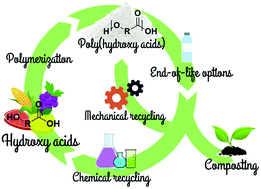Poly(hydroxy acids) derived from the self-condensation of hydroxy acids: from polymerization to end-of-life options
Abstract
Poly(hydroxy acids) have been gaining increasing attention in the search for novel sustainable materials to replace petrochemical polymers in packaging applications. Poly(hydroxy acids) are polyesters that are obtained using hydroxy acids as the starting materials, which are derived from renewable resources and biowaste. These biopolymers have attracted a lot of attention since some of them will be in the near future competitive in price to polyolefins, show excellent mechanical and barrier properties, and can be potentially recycled by physical and chemical routes. Most of the current poly(hydroxy acids) are mainly prepared by ring-opening polymerization (ROP) of cyclic monomers derived from hydroxy acids. However, their direct polymerization has received much less attention, while one of the advantages of hydroxy acids resides in the presence of an electrophile and a nucleophile in a single molecule that makes them ideal A–B type monomers for self-condensation. This review focuses on the preparation of poly(hydroxy acids) by the self-condensation polymerization of hydroxy acids. Moreover, their end-of-life options are also evaluated considering not only their biodegradability but also their potential to be chemically recycled.

- This article is part of the themed collections: Polymer Chemistry Lectureship Winners and Plastics in a circular economy


 Please wait while we load your content...
Please wait while we load your content...